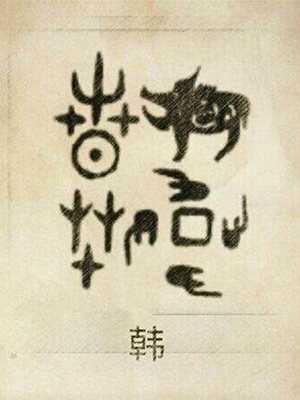Origins of the Han(hán) Surname: Royal Roots and Cultural Blending

- The Royal Ji Bloodline
The Han(hán) surname traces its origins to the Ji family of the Zhou Dynasty (1046–256 BCE), China's foundational royal house. According to historical records, a son of King Wu of Zhou was granted the territory of Hanyuan (modern-day Hancheng, Shaanxi Province) during the early Western Zhou period. This land became the State of Han, one of China's earliest feudal states. When the state was conquered by the Jin Kingdom in 757 BCE, descendants of its last ruler, Han Wuzi, adopted "Han" as their surname, establishing the primary lineage.
- Multicultural Influences
The Han surname reflects China’s history of ethnic integration:
Xianbei Adoption: During the Northern Wei Dynasty (386–534 CE), the Xianbei ethnic group’s Chu Da Han Clan adopted "Han" as part of cultural reforms.
Manchu-Mongolian Integration: In the Qing Dynasty (1636–1912), Manchu Hanzha and Mongolian Jilate clans merged their identities with the Han Chinese.
Southern Acculturation: From the Tang to Song Dynasties (7th–13th centuries), indigenous groups in southwestern China, like the Zhuang people in Guangxi, adopted the Han surname during cultural assimilation.
Historical Figures: Luminaries Across Millennia
- Politics & Military Leadership
Han Fei (Warring States Period, 475–221 BCE): Philosopher and legal theorist who authored Han Feizi, foundational to China’s legalist tradition. His concepts of "law, strategy, and power" influenced governance for two millennia.
Han Xin (Western Han Dynasty, 202 BCE–9 CE): Military genius credited with helping Emperor Gaozu unite China. His tactical masterpiece, the "Battle of Jingxing," remains studied in military academies.
Han Shizhong (Southern Song Dynasty, 1127–1279): National hero who resisted Jurchen invasions, celebrated alongside General Yue Fei.
- Arts & Literature
Han Yu (Tang Dynasty, 618–907): Leader of the "Ancient Prose Movement" and foremost of the Eight Great Prose Masters. His essays like Shi Shuo ("On Teachers") revolutionized Chinese literary tradition.
Han Gan (Tang Dynasty): Imperial painter renowned for his equine portraits, notably Night-Shining White, a masterpiece of Tang art.
Han Huang (Tang Dynasty): Statesman-painter whose Five Oxen is China’s oldest surviving paper-based artwork.
- Science & Education
Han Gonglian (Northern Song Dynasty, 960–1127): Astronomical engineer who co-designed the Water-Powered Armillary Sphere, considered a precursor to mechanical clocks.
Han Qide (Modern Era): Pioneering pathophysiologist and former president of the China Association for Science and Technology.
Migration & Family Traditions: From Central China to the World
- Historical Migration Patterns
Qin-Han Era (221 BCE–220 CE): Spread from Henan and Shaanxi to Hebei and Shandong, forming influential clans like the Nanyang Han and Changli Han.
Tang-Song Southern Migration: Post-8th century An Lushan Rebellion, Han families relocated to Jiangsu, Zhejiang, and Fujian. Northern Song Prime Minister Han Qi’s clan settled in Quanzhou.
Overseas Diaspora: During the Ming-Qing periods (1368–1912), Fujianese Han families migrated to Taiwan and Southeast Asia, while Guangdong clans settled in Malaysia and Singapore.
- Cultural Heritage
Ancestral Halls & Genealogies: The Han Yu Memorial Temple in Mengzhou, Henan, honors the literary giant, while Fujian’s Zhangzhou preserves a Yuan Dynasty (1271–1368) Han genealogy text.
Family Values: The Changli Han clan’s motto, "Farm with diligence, study with devotion," and Ming Dynasty scholar Han Lin’s Shou Yu Quanshu ("Book of Defense") emphasize education and civic duty.
Cultural Impact & Modern Significance
- Philosophical & Literary Legacy
Legalist Foundations: Han Fei’s theories shaped China’s centralized governance system, influencing East Asian political thought.
Literary Revolution: Han Yu’s prose reforms earned praise from Song Dynasty poet Su Shi: "He lifted literature from eight generations of decline."
- Economic & Scientific Contributions
Historic Trade Networks: Ming-Qing era Shanxi Han merchants facilitated tea-horse trade along the Ancient Tea Route.
Modern Innovation: Contemporary Han scientists excel in aerospace (e.g., Han Houjian’s contributions to Long March rockets) and AI (e.g., Jiawei Han’s data mining breakthroughs).
- Cultural Resonance Today
Cultural Revival: Han Yu’s hometown hosts an annual Han Yu Cultural Festival, while Han Feizi inspires TV dramas and films.
Global Connections: The World Han Clan Association connects over 40 countries, promoting Chinese heritage through education and cultural exchanges.
Conclusion
The Han surname embodies China’s enduring cultural DNA—a tapestry woven from royal lineage, philosophical innovation, and adaptive resilience. From Han Fei’s legal theories to Han Yu’s literary genius, and from ancient migration trails to Silicon Valley labs, the Han legacy demonstrates how a family name can transcend bloodlines to become a bridge connecting past and present, East and West.